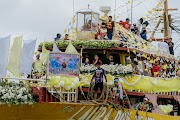With the local arrival of America during the Spanish American War (April 21 – August 13, 1898) architecture and our way of life in our tropical island was forever changed.
The birth of our local neoclassical architecture came from necessity more than aesthetics. Erected structures showcased American superiority plus the interpretation and appropriation of American colonial architecture and culture became distinctly Pinoy.

The American forces did not build homes for their resident Americans or the colonized locals. Overtly or more cleverly they erected military style dwellings that could be easily fortified and defended.
It was the Filipino elite who first created their own American style residences. Copied mostly from existing architectural designs – since there were few professional architects available for private hire. These newly constructed homes were mostly wooden structures built in the adapted and appropriated “American” style.
Negros Island conjures images of the pre-civil war life of America’s old south. Bacolod was the bastion of aristocratic hacenderos with vast sugar plantations, employing thousands of sacadas to work in fields and azucareras.
The houses for the elite then are now woven tightly into current family histories and track their rise or fall in economic and social prominence. Here in Negros, when sugar crops failed around the world, our local sugar barons got to live like kings and show off their wealth in high style.
Even our far-flung island was subject to the global repercussions of the Spanish-American war – particularly the economic trade with Cuba, which caused a surge in our own locally grown sugar and tobacco. Being a rich agricultural island, Negros played a central role in this arena.
While many of their old mansions have since fallen into ruin, the Presbitero house has continued to keep its Old World beauty despite massive upheavals that have occurred. This is largely due to the dedication of generations of its heirs, who have maintained this home with pride and care.
The story of this pristinely maintained home has been largely lost, including the history of its incredible architect - Kokichi Paul Ishiwata, famous for building the local Mambucal Bath House in 1927.
A trailblazing architect, he was a former colonel in the Japanese reserve army. To practice architecture independently - designing notable structures in a remote tropical island in the 1920s – is highly unusual.
While other local architects from the time have been lauded for their contributions to the environment - Ishiwata, arguably an architect whose works have outlived him, has mostly faded from public memory. It is really too bad that this story is now lost to us.
The Presbitero house was a wedding gift to Don Guillermo Presbitero and Theresa Lacson in 1933. Two identical houses were constructed – the Lacson house in Talisay which no longer exists, and this Presbitero home in Valladolid, Negros Occidental.
Marked by its distinctive pagoda staircase similar to the temple steps of Japan – the house also came fully landscaped. Complete with fountain, fruit trees, and floral garden. This is how generations remember growing up there fondly. Their family playground provided all their food, fun, and sustenance as well.
Typical of the wooden homes built at the time the structure was designed to accommodate both trade winds - amihan (northeast monsoon) and habagat (southwest monsoon). High ceilings, huge sliding windows, and ventilated walls keep it cool and well lighted. Terraces and verandas open the house up even more – cooling it in the extreme heat and providing added cover during fierce tropical storms.
It is a well designed structure ideally suited to its environment and has provided a safe and happy home for the Presbitero family for decades from when it was first conceived and constructed. With lots of tender loving care it has survived the onslaught of time, the elements, island life, and local upheavals – man made or force majeure.
Today it stands as a living monument of fulfilling heritage to both past and present. May it continue on to a future that we can all share and enjoy.
Photos and Video by: Bakunawa Films



.png)
.png)
.png)
.png)
.png)








